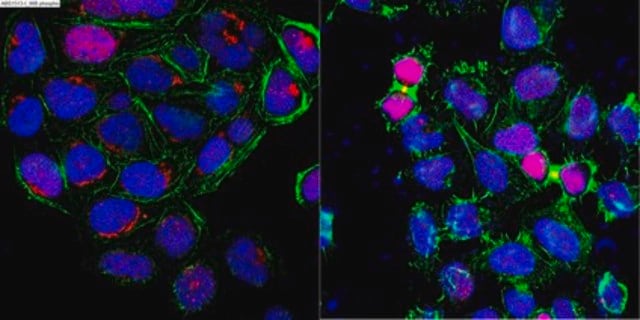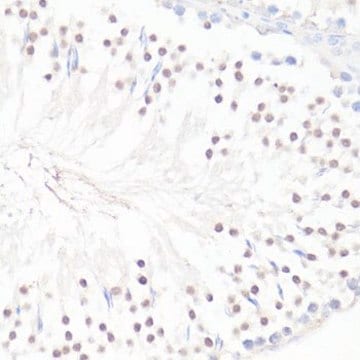05-1470
Anti-Raptor Antibody, clone 1H6.2
clone 1H6.2, from mouse
同義詞:
P150 target of rapamycin (TOR)-scaffold protein, p150 target of rapamycin (TOR)-scaffold protein containing WD-repeats, regulatory associated protein of mTOR
登入查看組織和合約定價
全部照片(2)
About This Item
分類程式碼代碼:
12352203
eCl@ss:
32160702
NACRES:
NA.41
推薦產品
生物源
mouse
品質等級
抗體表格
purified immunoglobulin
抗體產品種類
primary antibodies
無性繁殖
1H6.2, monoclonal
物種活性
mouse, human
技術
immunocytochemistry: suitable
immunoprecipitation (IP): suitable
western blot: suitable
同型
IgG1κ
NCBI登錄號
UniProt登錄號
運輸包裝
wet ice
目標翻譯後修改
unmodified
基因資訊
human ... RPTOR(57521)
mouse ... Rptor(74370)
一般說明
Raptor is a subunit of mTORC1 which regulates cell growth and survival in response to nutrient and hormonal signals. mTORC1 is activated in response to growth factors or amino-acids. Within mTORC1, Raptor positively regulates mTORC1 activity and functions as a scaffold for recruiting mTORC1 substrates.
特異性
This antibody recognizes Raptor.
免疫原
Epitope: Unknown
Recombinant protein corresponding to human Raptor.
應用
Anti-Raptor Antibody, clone 1H6.2 detects level of Raptor & has been published & validated for use in WB, IP & IC.
Immunocytochemistry Analysis: A 1:500 dilution from a previous lot detected Raptor in NIH/3T3 cells.
Immunoprecipitation Analysis: 20 µg from a previous lot immunoprecipitated Raptor in HEK293 cell lysate.
Immunoprecipitation Analysis: 20 µg from a previous lot immunoprecipitated Raptor in HEK293 cell lysate.
Research Category
Signaling
Signaling
Research Sub Category
PI3K, Akt, & mTOR Signaling
PI3K, Akt, & mTOR Signaling
品質
Evaluated by Western Blot in HEK293 cell lysate.
Western Blot Analysis: 1 µg/ml of this antibody detected Raptor on 10 µg of HEK 293 cell lysate.
Western Blot Analysis: 1 µg/ml of this antibody detected Raptor on 10 µg of HEK 293 cell lysate.
標靶描述
~ 150 kDa
外觀
Protein G Purified
Format: Purified
Purified mouse monoclonal IgG1κ in buffer containing 0.1 M Tris-Glycine (pH 7.4, 150 mM NaCl) with 0.05% sodium azide.
儲存和穩定性
Stable for 1 year at 2-8°C from date of receipt.
分析報告
Control
HEK 293 cell lysate
HEK 293 cell lysate
其他說明
Concentration: Please refer to the Certificate of Analysis for the lot-specific concentration.
免責聲明
Unless otherwise stated in our catalog or other company documentation accompanying the product(s), our products are intended for research use only and are not to be used for any other purpose, which includes but is not limited to, unauthorized commercial uses, in vitro diagnostic uses, ex vivo or in vivo therapeutic uses or any type of consumption or application to humans or animals.
Not finding the right product?
Try our 產品選擇工具.
儲存類別代碼
12 - Non Combustible Liquids
水污染物質分類(WGK)
WGK 1
閃點(°F)
Not applicable
閃點(°C)
Not applicable
分析證明 (COA)
輸入產品批次/批號來搜索 分析證明 (COA)。在產品’s標籤上找到批次和批號,寫有 ‘Lot’或‘Batch’.。
Abdessattar Khlaifia et al.
Molecular brain, 15(1), 56-56 (2022-06-18)
Hippocampal CA1 parvalbumin-expressing interneurons (PV INs) play a central role in controlling principal cell activity and orchestrating network oscillations. PV INs receive excitatory inputs from CA3 Schaffer collaterals and local CA1 pyramidal cells, and they provide perisomatic inhibition. Schaffer collateral
Sungki Hong et al.
Methods in molecular biology (Clifton, N.J.), 821, 29-44 (2011-11-30)
mTOR, an evolutionarily conserved Ser/Thr protein kinase, belongs to the PI3K-related kinase family, which also includes DNA-PKcs, ATM, and ATR. Although other PI3K-related kinase family members have been shown to secure genomic integrity by sensing DNA damage and related stresses
Julia Dyachok et al.
The Journal of biological chemistry, 291(43), 22414-22426 (2016-09-03)
The mechanistic target of rapamycin complex 1 (mTORC1) coordinates cell growth with its nutritional, hormonal, energy, and stress status. Amino acids are critical regulators of mTORC1 that permit other inputs to mTORC1 activity. However, the roles of individual amino acids
Radhika Chadha et al.
Neuropsychopharmacology : official publication of the American College of Neuropsychopharmacology, 45(6), 1059-1067 (2020-01-18)
Abnormal neurotransmission is central to schizophrenia (SZ). Alterations across multiple neurotransmitter systems in SZ suggest that this illness may be associated with dysregulation of core intracellular processes such as signaling pathways that underlie the regulation and integration of these systems.
Milagros Suarez et al.
Oncotarget, 12(10), 955-966 (2021-05-21)
The MAPK-interacting kinases 1 and 2 (MNK1/2) have generated increasing interest as therapeutic targets for acute myeloid leukemia (AML). We evaluated the therapeutic potential of the highly-selective MNK1/2 inhibitor Tomivosertib on AML cells. Tomivosertib was highly effective at blocking eIF4E
我們的科學家團隊在所有研究領域都有豐富的經驗,包括生命科學、材料科學、化學合成、色譜、分析等.
聯絡技術服務








